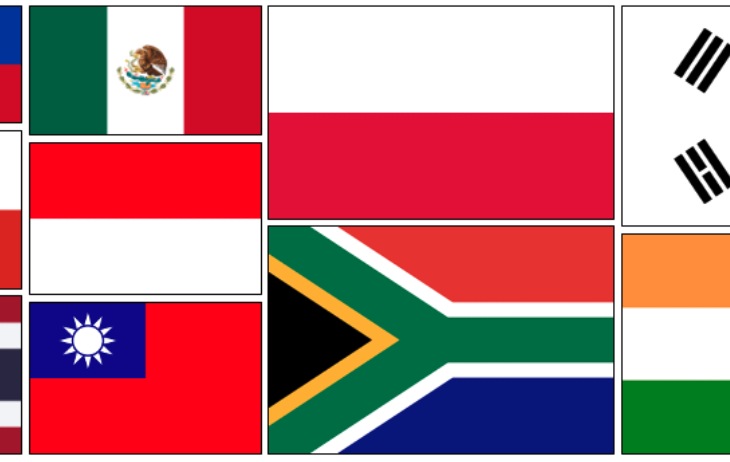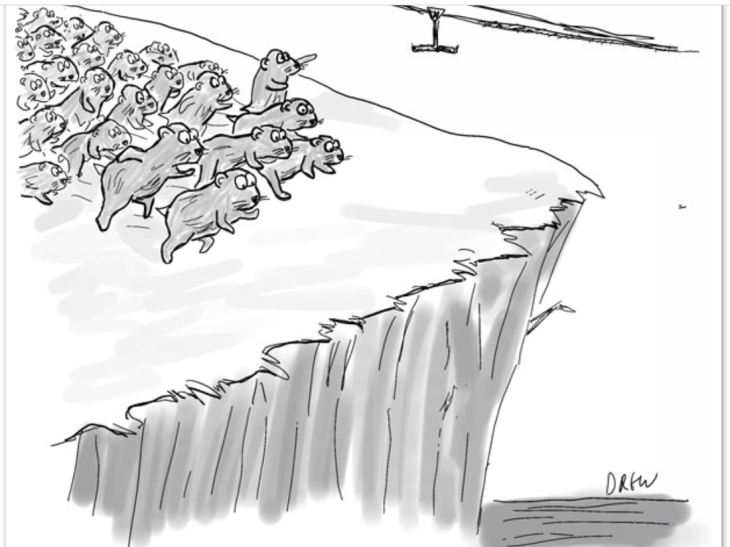Tim Ash: The Big Picture in Emerging Markets
 em-big picture
em-big picture
It’s been a while since I put out some generic bigger picture thoughts around EM, so here is a refresh/reset.
* Liquidity vs solvency
It’s been interesting in this Covid crisis as countries are encouraged to “spend, spend, spend” to buoy economies, and that the dominant ethos these days seems to be that high indebtedness is fine, and what matters is the affordability of that debt. Guess that is what happens when we have lived globally now for an extended period of time in an era, or generation or two, of deflation and disinflation, and QE.
For EMs living on the edge, that has meant that when some get into trouble and need to go cap in hand to the IMF the Fund seems to focus on the GFN/GDP ratio and not as much the old school Debt/GDP ratio. This means that in debt restructuring talks its now all about extending and pretending, less about hair cuts but more about debt service grace periods. Interestingly the concept of burden sharing and PSI seems to have gotten little traction. Within DSSI and the Common Framework attempts at PSI have been light touch, and not really serious. Not sure whether this is a conscious decision/change of policy, or it’s just a case of needs must and we don’t have time to complicate debt restructuring talks, we can come back to PSI if ultimately restructured debts of EMs are still unsustainable. Let’s just get things done quickly, and we need the private sector to not make hinge difficult so we need to leave cash on the table for them, But the immediate priority is liquidity support.
That’s been great for HY credit risk/performance, and for those commodity exporters a double positive.
But all good things come to an end
The above GFN vs Debt/GDP debate is fine while borrowing is cheap, and global interest rates are low, but something seems to be changing here with inflation rising. It feels like EM borrowing costs are just about to get a lot more costly, and that could be a challenge for those EM countries which cannot create real and nominal GDP growth going fast.
What is going on with inflation?
It’s nice to hear Fed policy makers offer reassuring words that the pick up in inflation is “transitory” and that the medium term outlook for inflation is benign. The reality is that they simply don’t know, as COVID makes most economic forecasts no better than guess work. I mean look at the conflicting trends over the past week in the US non farm payrolls and the inflation readings.
The reality is that COVID is fundamentally changing so many things in our lives. Just think that it is changing, likely in a permanent fashion, – where we live, what we buy, how we buy, our attitudes and to and how we use technology, how we live (eating out versus at home), how we work and where we work, attitudes to govt and fiscal policy (UK Tory govt growing money trees, who would have ever imagined that?).
It’s probably also changing politics which will have policy ramifications, hopefully positively – Trump out, hopefully populists science deniers out, and reward for capable technocratic leaders. But everyone seems to be Keynesian now or new monetary theory thinkers.
Importantly for inflation, it’s likely changing consumer baskets which makes forecasting inflation very difficult. Climate change driving food prices higher and higher commodity prices plus acceptance of fiscal dominance, higher minimum wages, likely will generate sustained inflation, unless the internet global market and China’s manufacturing prowess can still come to the rescue. But even there trade wars will likely dull the disinflationary impact. Well maybe.
So whatever the Fed might say, it simply does not know. It’s their hunch driven by past experience. And the problem with the Fed is that their views are discrete and binary – a bit like sell side bank recommendations. It’s their view until it is not. Just think over the CBR in Russia and their about turn on rates – they were dovish on March 12, and hawkish on March 19 when they hiked rates. What changed? As Harold Macmillan said: “facts my dear boy, facts”. So if inflation continues to surprise in the upside, the Fed will change their views. They are data driven and likely behind the curve.
That means that debt service costs for high rolling EMs will rise, and both liquidity and solvency will begin to matter again. I think.
SDR allocation – no such thing as a free lunch
The IMF USD650bn SDR allocation looked like a no brainer at first glance. Liquidity provision to EMs, at low cost. Great! Well, maybe not. It’s is kind of free money, well almost, as its very low interest when drawn and converted but never to be repaid. It appears as debt, so in country’s debt/GDP ratios. But the realisation I think is dawning at IMF HQ that this is creating a huge moral hazard play, actually weakening the desire of reform laggards to get on IMF programmes or hold to existing programmes.
The IMF SBA in Ukraine is a case in point. Let’s not beat around the bush, the programme is in trouble. A year in, and only one credit disbursement and no first review completed. Meanwhile, big issues to resolve, over the anti corruption agenda in particular, and the agenda on things to solve just keeps getting longer with the Naftogas crisis highlighting the near absence now of good corporate governance across SOEs, and gas/electricity issues. The hope was the looming debt service hump for Ukraine in Q3, when $3bn in external debt falls due, would concentrate minds in the Zelensky administration, but likely with $2.8bn in SDR allocations due in September now, I think there will be zero incentive on the part of the administration to do anything to meet the conditionality in the SBA. This SBA is dead now in my mind, as it expires at year end.
The SDR allocation has slowed reform and good policy outcomes and will be detrimental to the longer term growth and development story in Ukraine. And TBH, Ukraine was not desperately in need of the cash, with USD28bn in NBU reserves.
I could argue similar things with respect to both Turkey and Sri Lanka which face seemingly unsustainable balance of payments situations, and could do with going sooner rather than later to the IMF but their SDR allocations will prolong the pursuit of bad policy, and make the adjustment when it happens more, not less painful.
I think the SDR allocation was poorly thought thru, was seen as a quick fix for global policy elites, but will be outright counterproductive. It’s just bad policy – typical scatter gun approach, but actually killing a few in the melee.
Where is the good bottom up big EM story?
One of the problems with EM beta at the moment is that even if we debate and come up with a top down we like EM view, when it then comes to country allocation its gets difficult in actually identifying a good bottom up story. Whether it is Covid and pensions in Brazil, Covid in
India, sanctions in Russia, monetary policy and Erdogan in Turkey, political problems in Latin America. SA might not be looking quite as bad as tax revenues outperform on the commodity super cycle, but it’s only less bad on the fiscal, but still poor, while the structural growth story remains challenging.
Maybe we could say CEE – but where is the yield, and as inflation rises globally surely tight Labour markets there leave them vulnerable.
Commodity/oil plays stand out, and in the GCC we are seeing higher oil prices improve budgets, reducing issuance, while there is a sense of some real reform momentum now in Saudi, Oman and the UAE – fiscal consolidation and some social liberalisation.
But a general point across EM when we think about growth is that after the post Covid low base growth bounce, where is the structural growth story outside of commodities? Post GFC growth, and total factor productivity growth has slowed across EM – and not sure I ever believed the China and India real GDP growth data as its finger in the air stuff on both counts. But I relate this back to the impact of free or cheap money through the GFC, and QE in DM, which I would argue created a huge moral hazard play across EM, not fairly rewarding reform vs slow reform stories in terms of their costs of borrowing. And the result has been a marked slowing in structural reform, TFP growth and ultimately potential growth across Em, say compared to the reforming noughties, post the Czech/Asia crises.
I think this is important, as EM will come out of the Covid crisis with much more debt, and they will need nominal GDP growth to grow out of debt solvency concerns. Well I guess maybe some will get it thru inflation, which might help those with a weight of domestic debt (SA & India) but less so those with the skew to external indebtedness and their are plenty in that bucket.
ESG – help me out please!
Perhaps the biggest change I have seen in my 24 years now in the City is the advent of ESG. All fund managers are now increasingly obliged by end clients, and in the future regulators, to have ESG frameworks around their investments. I reckon I spend near a third of my time rating securities from an ESG perspective and/or thinking about ESG stuff. You could argue that we were doing that anyway, in for example thinking about the S and G factors driving good or bad policy outcomes in countries we covered. Maybe now much more emphasis S on E than in the past but that all of this has now just been given an acronym.
I tend to think that ESG will bring positive change, in that hopefully countries with better ESG profiles will benefit from lower borrowing costs, and this will encourage the laggards to follow. That’s the hope.
There are numerous problems with ESG at present but one is the subjective element, as however hard you try to include objective criteria, it all too typically ends up with a debate whether policy or human rights are better in country A versus country B. Are fund managers the best people to judge this? And it’s kind of interesting that to some extent Western society sets the objective functions herein perhaps with whatever is in vogue from our governments, media and NGOs at a point in time. A case in point here is that I always struggle with the ESG stories in Egypt versus Saudi. In particular, few people challenge the huge market long in Egypt, whereas they do in Saudi Arabia. But is Egypt rally a better ESG story than Saudi Arabia? That is a debate. But investments in Saudi Arabia are more likely to get a fund manager on to the front page of the FT than those in Egypt on ESG concerns, but which actually has a better ESG story?
But ESG is here to stay and is going to get bigger, and I think a growing trend will be rebalancing from E, to S and G. Indeed, countries typically like talking about E in roadshows when we raise ESG but many EMs struggle when it comes to S and G, either accepting failings or having a willingness to do anything about these. Climate change is important, for sure, absolutely, but the disproportionate focus on E, gives another impression of greening, not just within the E category but within ESG. A recent case in point, I recently engaged with a sell side bank on ESG risks in the GCC. I asked about their relative country rankings and the analyst went off about which had greener credentials. I then pulled him back about human rights, and the analyst was perplexed and responded that the market only cared about E. I think that is about to change with the new Biden administration’s focus on human rights and fighting corruption and kleptocracy, and likely sanctions rolled out therein.
This means that ESG and compliance departments will take a much closer look at S and G. And that means that fund managers will be obliged to ask issuers more trickery questions about S and G, including human rights. It will be interesting whether some of the weaker S and G countries are willing to be challenged and have well thought out responses and policies. Watch this space.
Perhaps the case of Russia is indicative herein as to how the focus on S and G is changing with the US sanctions regime. Indeed, despite Russia having a balance sheet to make a typical fixed income investor go weak at the knees, the main factor holding back performance in Russian fixed income assets is sanctions risks, and I think as the geopolitical setting is set to remain difficult, that this will remain the case, even get more difficult, with a real chance now of secondary sanctions on sovereign debt and more oligarch designations.
* Please note that any views expressed herein are those of the author as of the date of publication and are subject to change at any time due to market or economic conditions. The views expressed do not reflect the opinions of all portfolio managers at BlueBay, or the views of the firm as a whole. In addition, these conclusions are speculative in nature, may not come to pass and are not intended to predict the future of any specific investment. No representation or warranty can be given with respect to the accuracy or completeness of the information. Charts and graphs provided herein are for illustrative purposes only.
Follow our English language YouTube videos @ REAL TURKEY: https://www.youtube.com/channel/UCKpFJB4GFiNkhmpVZQ_d9Rg
And content at Twitter: @AtillaEng
Facebook: Real Turkey Channel: https://www.facebook.com/realturkeychannel/






